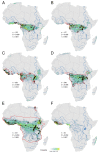Identifying the Most Probable Mammal Reservoir Hosts for Monkeypox Virus Based on Ecological Niche Comparisons
- PMID: 36992436
- PMCID: PMC10057484
- DOI: 10.3390/v15030727
Identifying the Most Probable Mammal Reservoir Hosts for Monkeypox Virus Based on Ecological Niche Comparisons
Abstract
Previous human cases or epidemics have suggested that Monkeypox virus (MPXV) can be transmitted through contact with animals of African rainforests. Although MPXV has been identified in many mammal species, most are likely secondary hosts, and the reservoir host has yet to be discovered. In this study, we provide the full list of African mammal genera (and species) in which MPXV was previously detected, and predict the geographic distributions of all species of these genera based on museum specimens and an ecological niche modelling (ENM) method. Then, we reconstruct the ecological niche of MPXV using georeferenced data on animal MPXV sequences and human index cases, and conduct overlap analyses with the ecological niches inferred for 99 mammal species, in order to identify the most probable animal reservoir. Our results show that the MPXV niche covers three African rainforests: the Congo Basin, and Upper and Lower Guinean forests. The four mammal species showing the best niche overlap with MPXV are all arboreal rodents, including three squirrels: Funisciurus anerythrus, Funisciurus pyrropus, Heliosciurus rufobrachium, and Graphiurus lorraineus. We conclude that the most probable MPXV reservoir is F. anerythrus based on two niche overlap metrics, the areas of higher probabilities of occurrence, and available data on MPXV detection.
Keywords: Monkeypox; Sciuridae; animal reservoir; ecological niche model; evergreen forests; tropical Africa.
Conflict of interest statement
The authors declare no conflict of interest.
Figures


References
-
- World Health Organization WHO Recommends New Name for Monkeypox Disease. [(accessed on 15 February 2023)]; Available online: https://www.who.int/news/item/28-11-2022-who-recommends-new-name-for-mon....
-
- Nylund A., Watanabe K., Nylund S., Karlsen M., Saether P.A., Arnesen C.E., Karlsbakk E. Morphogenesis of Salmonid Gill Poxvirus Associated with Proliferative Gill Disease in Farmed Atlantic Salmon (Salmo Salar) in Norway. Arch. Virol. 2008;153:1299–1309. doi: 10.1007/s00705-008-0117-7. - DOI - PubMed
Publication types
MeSH terms
LinkOut - more resources
Full Text Sources
Medical

